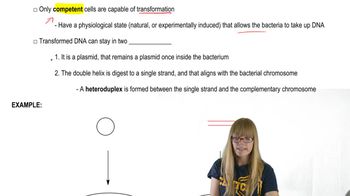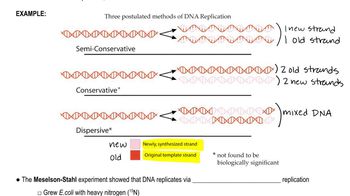The short DNA fragments created during lagging strand replication are called what?
Table of contents
- 1. Introduction to Genetics51m
- 2. Mendel's Laws of Inheritance3h 37m
- 3. Extensions to Mendelian Inheritance2h 41m
- 4. Genetic Mapping and Linkage2h 28m
- 5. Genetics of Bacteria and Viruses1h 21m
- 6. Chromosomal Variation1h 48m
- 7. DNA and Chromosome Structure56m
- 8. DNA Replication1h 10m
- 9. Mitosis and Meiosis1h 34m
- 10. Transcription1h 0m
- 11. Translation58m
- 12. Gene Regulation in Prokaryotes1h 19m
- 13. Gene Regulation in Eukaryotes44m
- 14. Genetic Control of Development44m
- 15. Genomes and Genomics1h 50m
- 16. Transposable Elements47m
- 17. Mutation, Repair, and Recombination1h 6m
- 18. Molecular Genetic Tools19m
- 19. Cancer Genetics29m
- 20. Quantitative Genetics1h 26m
- 21. Population Genetics50m
- 22. Evolutionary Genetics29m
8. DNA Replication
Overview of DNA Replication
Problem 1b
Textbook Question
In the discussion, we focused on how DNA is replicated and synthesized. We also discussed recombination at the DNA level. Along the way, we encountered many opportunities to consider how this information was acquired. On the basis of these discussions, what answers would you propose to the following fundamental questions?
How was it demonstrated that DNA synthesis occurs under the direction of DNA polymerase III and not polymerase I?
 Verified step by step guidance
Verified step by step guidance1
Understand the roles of DNA polymerase I and DNA polymerase III: DNA polymerase I was initially thought to be the primary enzyme responsible for DNA synthesis, but later research revealed that DNA polymerase III is the main enzyme involved in replication. DNA polymerase I primarily functions in DNA repair and processing Okazaki fragments during lagging strand synthesis.
Review experimental evidence: Researchers used mutant strains of bacteria (e.g., E. coli) that lacked functional DNA polymerase I. These mutants were still able to replicate their DNA, suggesting that another enzyme was responsible for DNA synthesis during replication.
Examine the purification and characterization of DNA polymerase III: Scientists isolated and purified DNA polymerase III from bacterial cells and demonstrated its high efficiency and fidelity in synthesizing DNA. This enzyme was shown to be capable of rapid and processive DNA synthesis, which is essential for replication.
Analyze in vitro replication experiments: In controlled laboratory experiments, DNA polymerase III was shown to replicate DNA templates effectively, while DNA polymerase I was unable to perform the same task at the required speed and efficiency. This provided direct evidence for the role of DNA polymerase III in replication.
Consider genetic and biochemical studies: Mutations in the gene encoding DNA polymerase III (dnaE) resulted in defective DNA replication, further confirming its essential role. Additionally, the presence of DNA polymerase III in the replication fork machinery, along with other proteins like helicase and primase, solidified its role in directing DNA synthesis.
 Verified video answer for a similar problem:
Verified video answer for a similar problem:This video solution was recommended by our tutors as helpful for the problem above
Video duration:
2mPlay a video:
Was this helpful?
Key Concepts
Here are the essential concepts you must grasp in order to answer the question correctly.
DNA Polymerases
DNA polymerases are enzymes responsible for synthesizing new DNA strands by adding nucleotides to a growing chain. In prokaryotes, DNA polymerase III is the primary enzyme for DNA replication, while DNA polymerase I plays a role in removing RNA primers and filling in gaps. Understanding the distinct functions of these polymerases is crucial for grasping how DNA synthesis is directed during replication.
Recommended video:
Guided course

DNA Proofreading
Experimental Evidence
Demonstrating the specific roles of DNA polymerases often involves experimental evidence, such as genetic mutations or biochemical assays. For instance, studies using temperature-sensitive mutants of E. coli have shown that when DNA polymerase III is inactive, DNA replication halts, indicating its essential role. This type of evidence is vital for distinguishing the functions of different polymerases in DNA synthesis.
Recommended video:
Guided course

Transformation
Replication Fork
The replication fork is the area where the DNA double helix unwinds and separates to allow for replication. At the replication fork, DNA polymerase III synthesizes the new DNA strand in a 5' to 3' direction, while other proteins assist in stabilizing the unwound DNA. Understanding the dynamics of the replication fork is essential for comprehending how DNA polymerase III directs the synthesis process during replication.
Recommended video:
Guided course

Semiconservative Replication
Related Videos
Related Practice
Multiple Choice
845
views
2
rank


